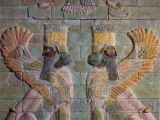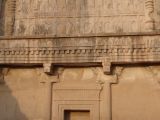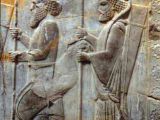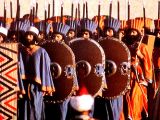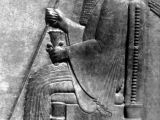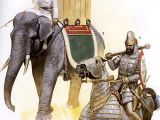The civilizations of Egypt and Middle East had already ages measured in millenia when the Iranian nomad tribes of the Medes and Persians left the steppes to establish in the Iranian Plateau, 3,000 years ago. The Medes settled in the south of the Caspian Sea, the Persians in the southeast, in the area of what we call today the Persian Gulf (Shiraz). Before the arrival of the Iranian tribes, the plateau was inhabited by the Hurrites and other non Indo-European tribes. Unlike as depicted in the movie "300", Persians were (and are) typical White people, with some blue eyed individuals and sometimes light haired (even Arab chronicles and stories stress that Persians are much lighter skinned than Arabs).
They were less developed than the neighboring people, like Assyrians and Urartu, but they brought the Zoroastrian system of religion and ethics that still survives, a belief that humans can choose between good and evil. Avesta was a collection of sacred texts expressing the Zoroastrian doctrine. Zoroaster had been a religious reformer which preached the existence of a supreme god, Ahura Mazda, lord of the good and creator of the world, identified with the sky light. Its emblem was the Sun and its representation was a winged circle with bird tail. Minor deities were called yazatas, which many times were represented as winged animals with human heads. Opposed to the God was Ahra-Manyu (later, Ahriman), lord of the darkness, and led a legion of evil spirits causing all the misfortunes on Earth. The gods were offered sacrifices and sacred fires were maintained burning on the top of the large towers.
At the beginning, the Medes were stronger, and made an union of tribes with the capital at Ecbatana that pretended tribute from Persians. But Medes themselves had been the vassals of the Assyrians, until their king Cyrxartes allied with the Chaldeans (Babylonians) and conquered the Assyrian capital, Ninive, in 612 BC, wiping out the Assyrian empire. The new Mede empire comprised Mesopotamia, Palestine, Syria and part of Asia Minor.
But Persians united under a genius leader, Cyrus the Great, who founded the dynasty of the Achaemenides. In 559 BC, Cyrus started the fight against the Medes and built a huge empire comprising Iran, Armenia and Asia Minor (today Turkey). In 546 BC, Cyrus conquered Lydia and Greek cities on the coast of Asia Minor. His campaigns led him to the Hindu Kush mountains (in modern Afghanistan). His son, Cambyses II conquered the whole Egypt, an unique deed by those times.
The appearance of an aspirant to the throne and the revolts of the Babylonians and Medes impeded Cambyses invade Libya and Ethiopia. At his death, he left no direct heir, but Darius, the leader of the 10,000 Immortals (the Royal Guard) pretended his descending from Achaemenides and was crowned as the new king. In two years, he crushed the revolts and, by 486 BC, he had extended the border of the empire to the Indus River.
The Persian Empire comprised people of various religions and ethnicities, but Persians did not attempt to rule through terror, like the Assyrians, but to conciliate various groups. Local governors ruled the 20 satrapies forming the empire. Customs, laws and public institutions were respected and all religions tolerated: one example is the reconstruction of a temple in Jerusalem, which had been destroyed by the Babylonians.
The capital of the Persian empire was Persepolis, rather a ceremonial center than a city. The Persian civilization is famous for its enormous palaces, but Persian villages were made of adobe houses, whitewashed to reflect the heat. The Persian houses were gathered and possessed terraces and terraced roofs accessible from external stairs, with very few windows.
Persian men wore curly beards and earrings; long trousers and short tunics. The clothes fitted horse riding. Persians wore folded-edged hats, while Medes wore rounded hats.
Persians were artistically heavily influenced by the Urartu kingdom and adapted the cuneiform writing to Persian. Persian jewelers were inspired by the Assyrian models and that of the craftsmen of Luristan and Lydia.
The Persian kings were buried in giant tombs, carved on the vertical walls of rocky cliffs. The facades of the tombs were adorned with depicting the king in front of Ahura-Mazda, while friezes could present lines of characters worshiping the God and rendering to the king. The entrance gate was flanked by 4 columns, also cut in rock, leaning a false cornice.
All the subjects of the empire served in the army, which turned cosmopolitan. A well developed road system boosted trade and communication; prosperity was promoted by the use of money (an invention from Lydia) as gold standardized coins. Such a large and fragile empire (the biggest until then) survived remarkably for 200 years. The peak had been reached during the rule of Darius. In 512 BC, Darius crossed the Bosphorus trying to defeat the Scythe tribes located beyond the Danube. 20 years later, he remade the route, occupying Thrace up to the border with Macedonia.
After crashing a revolt of the Greek cities on the coast of Asia Minor, Darius attempted to act on the Greeks from the mainland. The army sent in 490 BC to punish the Athenians for the help accorded to the Asian Greeks was defeated at the Battle of Marathon. But this was a small defeat, and Xerxes, the son of Darius, prepared a larger invasion, whose results were disastrous following the battles of Salamina (480 BC), Plataea and Mycale (479 BC). In 446 BC, Persia decided to make peace.
Persians were good riders and employed war chariots. Persian archers were famous for their powerful 2 m (6.6 ft) long bows. Persian troops wore helmets, shields and shin guards, but their infantry was much weaker than the hoplites (Greek foot soldiers).
As they were steppe riders at their origin, the art of navigation was foreign for them. A Greek explorer, Scylax, was sent by Darius, and navigated by 515 BC from the Persian Gulf into the Indian Ocean, surrounded the Arabian peninsula, entered the Red Sea and finished its adventure where today is the Suez Channel. When the Persian Empire attacked Greece, their fleet was led by a Phoenician admiral. The entire Persian fleet was destroyed at Salamina.
Greek mercenaries played an important role in the revolts and civil wars between the rival groups fighting for power and which shook the empire.
The empire was visibly in decline, and only the fights between the Greek cities escaped it.
But Darius III had the bad luck to face Alexander the Great, who started his famous campaign, during which he conquered the Persian Empire (334-324 BC). Following the conquest of Alexander, Persia turned into a kingdom led by the Greek Seleucid dynasty. Pathians, another Iranian tribe, revolted against the Seleucids in the third century BC, forming a kingdom that survived till 224 AD, when the Persian Ardeshir Babakan defeated them and founded the Sassanid dynasty. Sassanids considered themselves descendants of the Achaemenides and Persia experienced a revival of several centuries.
Sassanids created an army based on a strong chivalry, armed with bows. Art boomed and palaces were decorated with reliefs and carvings. Beautiful jewelry and woven fabrics, with gold thread, got famous around the world, being exported everywhere.
The Sassanids collapsed during the 7th century AD under the Arabs, who brought Islam. Persia changed forever. As human representation was forbidden by Islam, Persian artisans started creating art objects displaying sophisticated interwoven geometrical motifs.
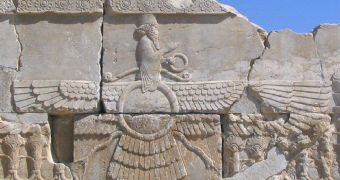
 14 DAY TRIAL //
14 DAY TRIAL // 
